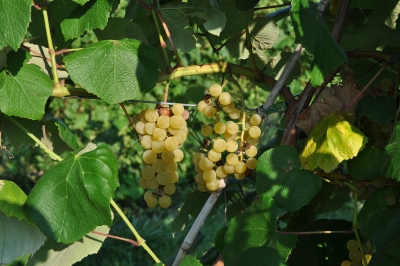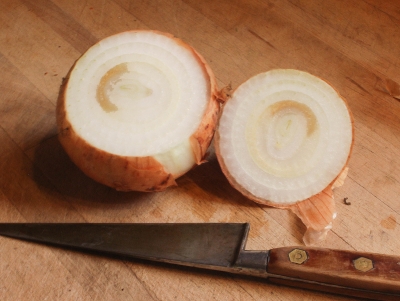Grapes And Onions
So Many Choices, In Grapes
With over 5,000 varieties of grapes from which to choose, how can anyone decide which to grow? For better or worse, that choice is naturally limited by climate and pests in each part of the country. Here in the northeast, major limitations are humid summers that spread indigenous disease and frigid winter temperatures.
There’s still plenty of grape varieties from which to choose, which I’ve done over the years, weeding out varieties that would succumb to cold or disease. My varietal possibilities are further limited by my low lying land close to acres upon acres of forest. Cold, moisture-laden air sinks into this low spot, and the abundance of wild grapes clambering up forest trees provide a nearby reservoir of insects and disease spores.
With all that, I want to grow varieties that taste good to me (fresh, not for wine). I have dairy farmer-cum-grape breeder Elmer Swenson to thank for many of the delectable varieties that bear well here, and that I would recommend to others. His Somerset Seedless was ripe back in August, as was his seeded Swenson Red. Right now, the seeded variety Brianna — one of my favorites for flavor — is just finishing, just after Edelweiss and Lorelei.

Swenson Red Grape
Edelweiss has the strong, “foxy” flavor characteristic of American-type grapes, so is not for everyone. That flavor is most familiar in the well-known variety Concord, originated by Ephraim Bull in Concord Massachusetts over 150 years ago. I finally got around to planting a Concord vine a few years ago, and finally decided this year, despite my affinity for grape foxiness, that I didn’t like Concord’s flavor.

Edelweiss grape
Mr. Swenson isn’t responsible for all my favorite grapes. There’s Alden, with a nice, meaty texture to go with its distinctive flavor. And two excellent, seedless grapes: Glenora and Vanessa. I’m going to rip Concord out of the ground, as well as Cayuga White, which also didn’t make the flavor cut, and Mars, which gets too much disease, and replace them with additional vines of Glenora and Vanessa. The jury is still out on Wapanuka, Reliance, and NY Muscat.

Concord grape
All my “keeper” varieties bear reasonably well and are bursting with distinctive, delicious flavors such that I cannot, even when grape season has passed, bring myself to eat the relatively flavorless varieties generally offered from supermarket shelves.
Rotting Onions
How are your onions holding up? Mine, not so well. I knew that the giant Ailsa Craig onions weren’t keepers. But they shouldn’t be already turning soft and smelly.
Some sleuthing uncovered the culprits: the bacteria, Pantoea agglomerans and/or its cousin P. ananatis, both of which can be lumped together in the affliction called “center rot.” The symptom is rotting of one of the rings (scales) somewhere between the center and the outside of a bulb.
Most plant diseases are caused by fungi rather than bacteria, and fungal diseases are generally easier to control. Even pesticide sprays are not very effective against either onion pathogen. Warm, moist conditions are what have allowed the Pantoea cousins to thrive this year.
Which is not to say that I plan to sit back and watch my onions spoil in future years, or give up growing onions. I already rotate my onion plantings, which would have been my first plan of attack. Although now that I think of it, though, I do often stick a few of various types of onions and excess seedlings here and there around the garden. No more.
The environment can be made less friendly to the bacterium. Mulching the plants would keep the soil cooler. Especially a few weeks before harvest, any watering should cease. Nitrogen fertilization also needs reining in, which would be hard to do in my garden because I fertilize only with compost. Perhaps mulching would cool the soil enough to slow the compost’s mineralization of soluble nitrogen that plants could absorb.
Onion varieties vary in their susceptibility to center rot. Generally, it is the sweet, European type varieties, such as Sweet Spanish, Candy, and Ailsa Craig, that are most susceptible.
Harvest can play a role also. Too early, before leaves have sufficiently dried and flopped down, and the bacteria might be able to edge its way into the bulb. I normally harvest when tops flop down and bulbs easily roll out of the soil (good), then leave them in place to cure in the sun (bad). Next year, I’ll roll them out of the soil and then move them to a shaded, airy place to cure. Or lay them out in the garden so each onion’s leaves covers its neighboring onion’s bulb.
All these measures are worthwhile even if your onions have always looked fine. Center rot bacteria are pretty much ubiquitous, just waiting for good enough conditions to ruin your (and my) onions.


The jury is out on NYM? Surprising. I’ve grown it in San Diego since the early 1990’s, it’s superb here. Especially when grafted onto Pierce’s Isabella, which makes NYM more vigorous and productive.
On that matter of Alden, I got that variety, as labelled, from Rombough Vineyards, but the fruit were non-distinctive vinifera in flavor, with an unexpected persistant acidity. (I’m two blocks from the ocean, but Muscat Ottonel ripens well here, under basically same conditions, and NYM, Ontario, Pierce’s Isabella, Verdelet, Cayuga,… all good here). As for the identification of it, the fruit were even-elliptical, not round. What shape are your Alden? I realize terroir can be a factor. And, the leaves are relatively corrugated compared to other grapes, with a faint unusual irridescence sheen on the leaf corrugation’. Does that sound like Alden to you? I may have to get some cuttings from UCDavis to see if theres is different from the Rombough source of Alden. I grafted Muscat Ottonel onto the Alden last year and the MO is growing great. Btw, Brianna, Swenson White, Esprit, Alpenglow have leaf disease problems here. I even grafted Dattier St. Vallier onto Esprit, grows well, but it’s also getting the same brown-spotty leaf disease as the Esprit, although I grew Dattier inland about 15miles but not leaf-disease problem,… and, I also grafted Dattier onto Alpenglow, growing great and none of that Esprit type leaf disease showing yet on that Dattier graft. Alpenglow leaf disease is differnt and less severe compared to the spotty/stripey brown leaf disease on Swenson White and Esprit. They all have MN78 in there ancestry, so, I figure that lineage is typically not so good for my location: Sandy-ish soil, two blocks from the ocean.
Best regards,
Scott
I think a lot of what you report reflects growing conditions you have that are very different from mine hee in NY’s Hudson Valley.
Hi Lee, thank you for your response.
How does the Melody grape flavor and sugar balance compare with Cayuga?
Btw, I also found that Cayuga was not enjoyable enough to me,… something about the sugar balance,… too icky sweet for me, I’m supposing more fructose than glucose, which makes the grapes icky sweet to me, simply as a matter of sugar balance. Whereas New York Muscat has always had excellent sugar balance to my senses. Cayuga is more palatable on the early side of ripeness, which is consistent with research I’ve read of glucose being more present and fructose being less present on the early side of ripeness. Some tannin also with Cayuga which is ok, I don’t mind that,… a bit of tannin gives some additional good texture and sensation,… a bit of good toughness, a bit of bite.
And to be clear, I’m referring to Cayuga White, and Melody of similar parentage, both ‘white’ grapes from the same breeding program.
Thanks!
I never grew or tasted Melody. In Cayuga, so far, it’s the tannin that’s throwing me off.